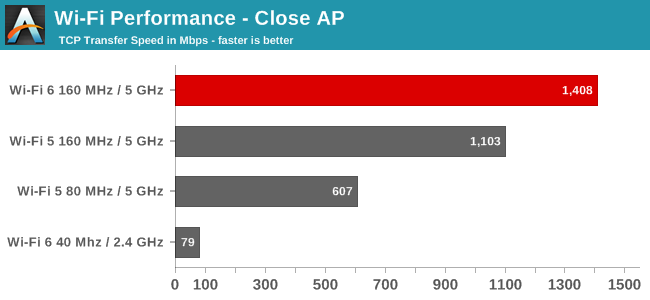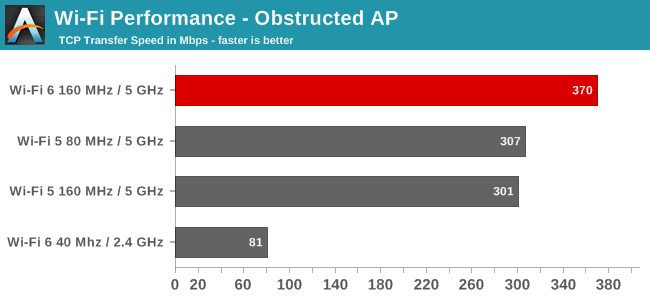AT 101: Wi-Fi 6 And Why You Want It
by Brett Howse on February 12, 2020 8:00 AM ESTPerformance
In order to achieve maximum performance, the latest Wi-Fi 6 standard leverages 1024-level QAM, but depending on the signal strength and quality it will scale down as needed, so to achieve the best performance very high signal to noise ratios are going to be required. Since 5 GHz is attenuated dramatically when it has to go through walls, if you need maximum Wi-Fi performance be aware that you are going to want your wireless router as close to the end device as possible. Luckily that is not an issue in our case, since the router is in the same room when testing for maximum performance, but we’ll also evaluate it in less than ideal scenarios as well.
Wi-Fi 5 vs Wi-Fi 6 – Close AP
First up we’ll test the TCP performance when the Access Point is in the same room as the client.

The performance advantages of Wi-Fi 6 are clear. With the access point in the same room, the SNR is very good and the new 802.11ax standard can really shine. With 1024 QAM and 160 MHz channels, the performance is over twice as fast as the outgoing Wi-Fi 5 with 256 QAM and 80 MHz channels. It is very impressive to see a typical 2x2:2 connection well over the Gigabit barrier, and even though the AX200 network card is the first generation, Intel has already done a fantastic job tuning it. The theoretical maximum transfer rate with 160 MHz channels and 1024 QAM is around 1200 Mbps per connection, so a 2x2 can in theory hit around 2.4 Gbps, meaning there's still room for improvement. Since 802.11ax also can be used on the 2.4 GHz frequency, unlike 802.11ac, the same test was also done on 2.4 GHz, and the results were disappointing. 2.4 GHz can still offer 40 MHz channels, but it doesn’t seem like the AX200 could take advantage of any of that. For reference, the wireless adapter in the laptop was reporting -21 dBm, which is a strong signal, which makes sense since the AP is almost right next to the laptop.
Wi-Fi 5 vs Wi-Fi 6 – Reduced Signal
Moving the laptop further away, and adding several walls and doors in the way to attenuate the signal, the same scenarios were again tested.

With some walls in the way, 5 GHz gets attenuated quite dramatically, and the SNR in the second location was -78 dBm. With such a low signal, the Wi-Fi 6 connection wasn’t able to take advantage of the 1024-level QAM and would have had to drop down to a much lower set, reducing the number of bits per tone, and even though the total channel bandwidth was still 160 MHz, it was only marginally faster on 802.11ax than 802.11ac 80 MHz. 2.4 GHz is not as impacted by walls, and as such was able to maintain the same transfer rate, even though it was still quite a bit slower.
So the results are clear. Wi-Fi 6 can offer a significantly higher level of throughput than Wi-Fi 5, but in order to do so, it needs a strong signal. The Wi-Fi 6 still outperformed the Wi-Fi 5 in the second test with an attenuated signal, but the performance gain was minimal. 2.4 GHz still offers the best signal strength, and therefore would be able to connect further away, and through more obstacles, but doesn’t offer anywhere near the performance of the 5 GHz range. It will be interesting to see the Wi-Fi 6E devices with 6 GHz support when they launch. It will open up Wi-Fi to a wider set of frequency choices, but will offer even less range.










149 Comments
View All Comments
Makaveli - Wednesday, February 12, 2020 - link
True but using a 4 year old article in this example failed. In 2016 I was already using a Docsis 3.0 250/20 Cable connection. Yet that article shows 16mbps as the national average..By 2017 I was on a Docsis 3.1 500/20 cable connection and now in 2019 I moved up to a 1Gbps/750Mbps fiber connection.
The majority of cable providers in the US are still using Docsis 3.0 modems and within the last year or you are finally starting to see docsis 3.1 modems mostly because Comcast started to push them out.
triphoppingman - Wednesday, February 12, 2020 - link
"True but using a 4 year old article in this example failed. In 2016 I was already using a Docsis 3.0 250/20 Cable connection. Yet that article shows 16mbps as the national average"Anecdote vs Aggregated data? I know which one I prefer.
Makaveli - Wednesday, February 12, 2020 - link
haha well played sir.However most of the users on that cable ISP in canada I was using went thru the same Docsis 3.0-3.1 progression and that is one the biggest Cable ISP in Canada. And everyone sent from 250mbps connection to the eventual 3.1 Docsis with 1Gbps cable. So the numbers are bigger than just my example.
rrinker - Wednesday, February 12, 2020 - link
I have 350 down/15 up which is plenty fast for streaming and even downloading DVD size games 'updates', and I am not data capped.I can get up to 1Gb down, but I don;t want to pay more. I still pay the same as I did when I moved in when it was 200Mb down, speed has been upped 3 times with no change in the bill.
triphoppingman - Wednesday, February 12, 2020 - link
No, frankly, I don't trust an anonymous Internet poster. Not when the facts are not on your side. How is the weather up there?808Hilo - Wednesday, February 12, 2020 - link
The social trust index in the US is half of that in Canada. We made us 320 million sociopaths, So no matter what you say - the Murican will tell you that everything is better here. The murican actually believes this against better knowledge - while the facts tell that the american project is now the first and foremost failed state on this planet. Yep, internet here means gouging, unkept promises, lousy service at elevated pricing. Its ridiculously bad for the big majority. No dont trust the voice of an murican on the internet - and we should build a higher wall around the US - to keep them in.Makaveli - Wednesday, February 12, 2020 - link
What facts?AdhesiveTeflon - Wednesday, February 12, 2020 - link
Not gonna lie, Canada's cellphone coverage is phenomenal compared to anything in the US. I can be in the middle of the trans-canadian highway in Saskatchewan and still have at least 3G. I go 30 miles outside of chicago and I don't have any signal.JKflipflop98 - Thursday, February 13, 2020 - link
I get 1gig speeds from comcast for $45 a month over cable here in Oregon.flyingpants265 - Wednesday, February 12, 2020 - link
50% of the entire "Canada" lives pretty close to Toronto.It's kinda rare to have somewhere that won't get 50mbps as a minimum. Places in big cities get 1gbit+. No data caps either.